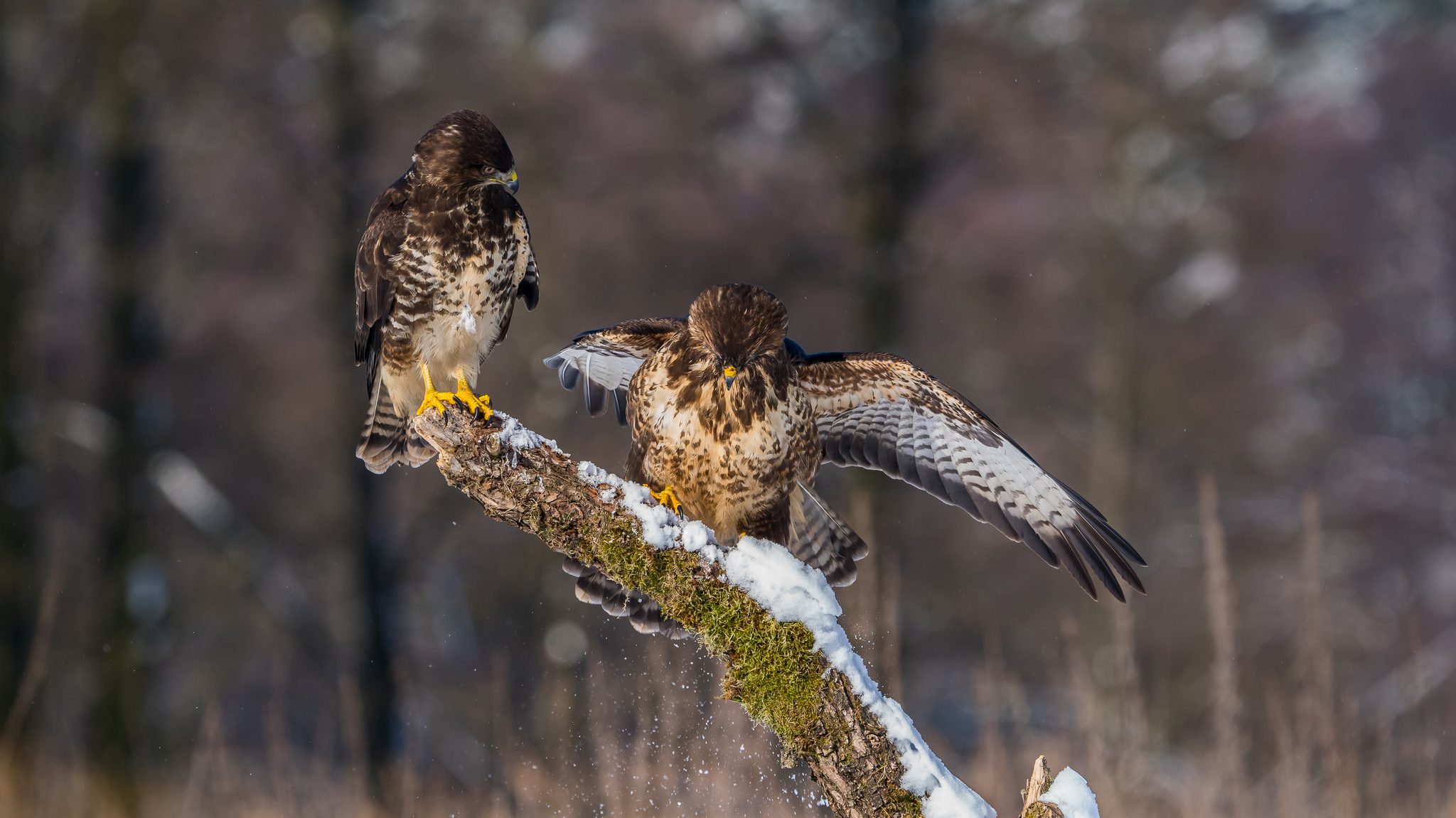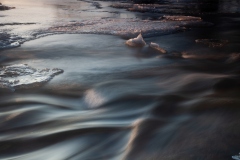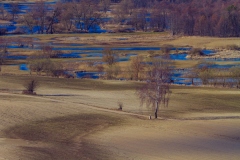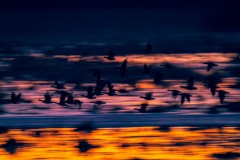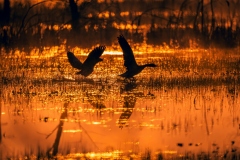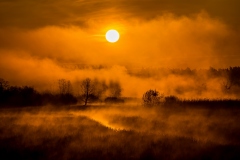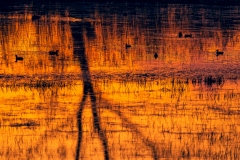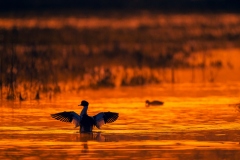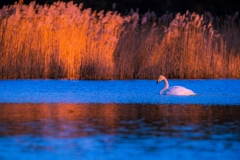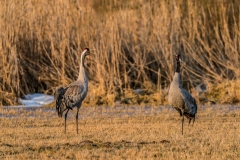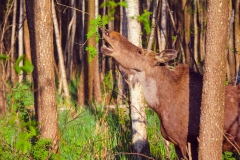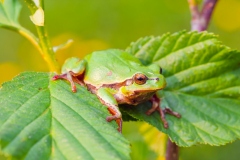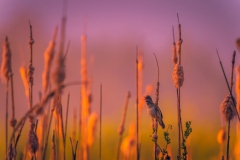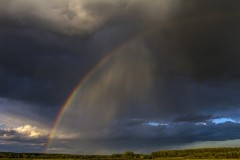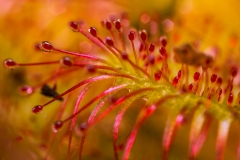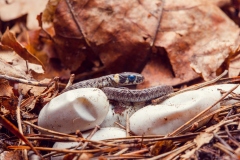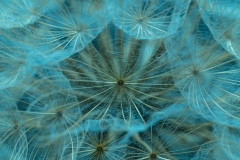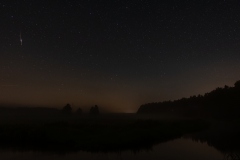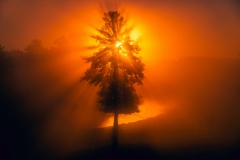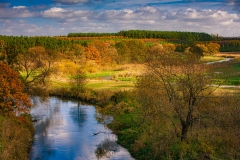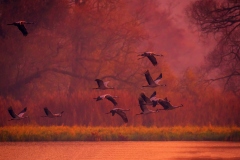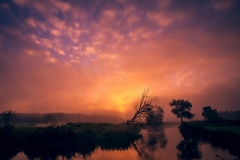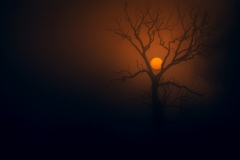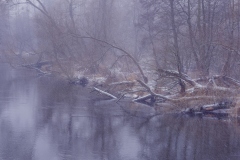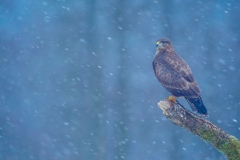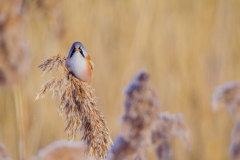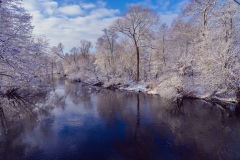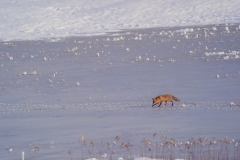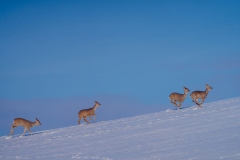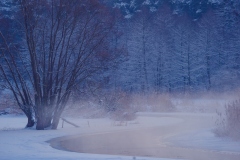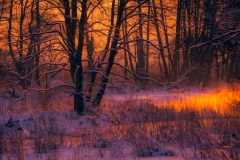Przejmująca cisza, która wypełniała Dolinę przez ostatnie miesiące, powoli ustępuje miejsca różnorodnym dźwiękom pojawiającym się, zarówno w nurcie Drwęcy, jak i w jej najbliższym otoczeniu. Rzeka, do tej pory pozostająca w uścisku grubej lodowej skorupy, zaczyna zrzucać jej okowy. Z nadzieją nasłuchuję odgłosów pękającego lodu i z wielką, niekłamaną przyjemnością obserwuję jak odpływa on niesiony coraz to bardziej bystrym nurtem wyzwolonej rzeki. Ta radosna, uwolniona Drwęca przejmuje panowanie na coraz to większych obszarach Doliny, zalewając je corocznym, życiodajnym wezbraniem. Rzecznemu spektaklowi przypatruje się jakby od niechcenia, obojętnie, bez emocji kamienny krzyż, świadek wydarzeń sprzed wieków. Z dystansem czasu i przestrzeni w bezpiecznej odległości od dynamicznej i kapryśnej Drwęcy. Tej gwałtownej ekspansji rzeki wtóruje coroczny, wyczekiwany przeze mnie odgłos przekrzykujących się tysięcy gęsi, które pojawiają się na rozlewiskach. Wykorzystują one te miejsca nie tylko do „dyskusji”, lecz przede wszystkim do odpoczynku i regeneracji sił po pokonaniu wielu tysięcy kilometrów. Ptaki te, po „przystanku w gościnnych progach Drwęcy” przygotowują się do pokonania jeszcze olbrzymiego dystansu w drodze na lęgowiska na Dalekiej Północy. Goście przybywają przeważnie po zachodzie słońca, a o ich obecności pod osłona nocy świadczą tylko ich głośne rozmowy. Wypijam mocną kawę i udaje się jeszcze w środku nocy w moje ulubione miejsca obserwacji, żeby przygotować się do fotografowania i filmowania tych okazjonalnych bywalców Doliny. Montuję sprzęt po omacku, w całkowitych ciemnościach i oczekuję odrobiny światła, które pozwoli mi na obserwację i dokumentowanie tego co odsłoni świt. Ilość lumenów, powoli, wzrasta, ukazując moim oczom tajemnicze sylwetki jakby – „zjawy”, które poruszają się ponad powierzchnią wiosennych rozlewisk. Świt, jakże przeze mnie wyczekany, eksploduje na niebie bogactwem faktur i kolorów. Po nocnym wypoczynku wędrowcy kierują swoje skrzydła w stronę słońca, które dopiero co wychyla się nad horyzontem i ruszają w dalszą podróż żegnając się z Doliną. Słońce, po okresie zimowego letargu z coraz to większą siłą i coraz szybciej podnosi się codziennie i oświetla rzekę ciepłymi promieniami. Nadbrzeżne drzewa kładą się ostrymi cieniami na rozlewiskach tworząc kompozycję „świetlnego patchworka, w który włączają się ptaki dynamicznie sunące po tafli wody. Pierzaści mieszkańcy Drwęcy i jej rozlewisk wystawiają swoje skrzydła w stronę wschodzącego słońca oddając mu cześć i chłonąc jego dobrą energię. Z wolna nad rozlewiskami nastaje cisza, po tym jak większości skrzydlatych przybyszów, powoli opuszcza swój „przystanek”, z rzadka tylko przerywana odgłosami stałych mieszkańców. Większość ptaków dobrała się już w pary i w poszukiwaniu odpowiedniego miejsca do założenia gniazda przeszukuje odludne uroczyska Doliny. Żyzne, nadrzeczne pola zaczynają pokrywać się delikatnym woalem młodej, soczystej zieleni ozimin. Radości z tego faktu nie kryją zające, które przez ostatnie miesiące były skazane na przymusową dietę. Podobnie, zieleniejące łąki, stają się miejscem sąsiedzkich spotkań podczas wspólnych posiłków saren i gęgaw, przerywanych od czasu do czasu sprzeczkami o dostęp do najsmaczniejszych, młodych ździebeł. W kwietniu następuje w Bagiennej Dolnie Drwęcy, kolejny etap – druga fala odwiedzin. Goście, pojawiający się w tym okresie, pozostają tu na dłużej korzystając ze szczodrobliwości tego miejsca, aby założyć rodzinę i przedłużyć gatunek. Trzcinowiska i wszelkiego rodzaju zarośla wypełniają się ptasimi trelami. Brzęczka swoim donośnym i jakże charakterystycznym głosem, ogłasza światu, że oto na kilka miesięcy obejmuje w posiadanie właśnie te okoliczne trzciny. Zacny Gospodarz tego terenu – łoś, po spędzeniu zimy w lesie sosnowym z lubością oddaje się pałaszowaniu świeżych i smacznych liści znalezionych w zalewowych terenach nad Drwęcą. Czas biegnie nieubłaganie, nadchodzi maj z ciepłymi, coraz krótszymi nocami, które rozbrzmiewają odgłosami godowymi naszych płazów, z których to szczególnie budzi sympatię rzekotka drzewna. Co ciekawe, inaczej niż nasze rodzime płazy, spędza ona większość swojego życia wśród liści drzew i krzewów, a opuszcza je tylko w okresie godowym, aby złożyć skrzek w rozlewiskach Drwęcy. Zanikający ptasi, godowy harmider i pojawiające się odgłosy piskląt – owoców ich miłości, świadczy o końcu tej najpiękniejszej i najciekawszej przyrodniczo pory roku. Dorosłe ptaki uwijają się jak w ukropie karmiąc wiecznie nienasycone „młode dzioby”. Czyni tak m.in. dudek, przybysz z dalekich Indii, tajemniczy barwny ptak z imponującym „czubem”, zamieszkujący stare, dziuplaste wierzby. Czas przebudzenia, nowego życia powoli się dopełnia. Coraz dłuższe, ciepłe dni uzmysłowiają nam, że nadchodzi czas zmian. Nadchodzi ciepłe i leniwe LATO.
| | The poignant silence that has filled the Valley for the past few months is slowly giving way to a variety of sounds emerging, both in the Drwęca stream and its immediate surroundings. Thus far remaining in the grip of a thick sheet of ice, the river is now beginning to shed its fetters. I listen with anticipation to the sound of cracking ice and watch with great genuine pleasure as it floats away carried by the ever brisk current of the freed river. This exhilarated, freed Drwęca takes hold of ever larger areas of the Valley, flooding them with its annual, life-giving surge. A stone cross, a witness to the events of centuries ago, watches the river spectacle somewhat casually, dispassionately, indifferently. From a safe distance in time and space away from the dynamic and whimsical Drwęca. This rapid expansion of the river is accompanied by the annual, much anticipated sound of thousands of geese shouting their way across the floodplains. They use these sites not only for “discussions”, but primarily to rest and recover after travelling many thousands of miles. These birds, after a “stopover at the welcoming junction by the Drwęca”, make preparations for travelling further enormous distance on their way to breeding grounds in the Far North. The visitors mostly arrive after sunset, and their presence under the cover of darkness is only evidenced by their loud conversations. I drink a strong coffee and make my way, still in the middle of the night, to my favourite observation spots to prepare for photographing and filming these occasional visitors to the Valley. I assemble my equipment blindly, in total darkness, and wait for a bit of light to allow me to observe and document what the dawn will reveal. The number of lumens slowly increases, revealing to my eyes mysterious silhouettes of a kind — “phantoms” floating above the surface of the spring floodplains. The dawn, so eagerly longed for, explodes in the sky with a plethora of textures and colours. After a night’s rest, the travellers point their wings towards the sun, which is only just rising above the horizon; and continue their journey as they bid farewell to the Valley. The sun, after its winter lethargy, rises with increasing strength and is rising faster and faster every day illuminating the river with its warm rays. The riverside trees cast stark shadows over the floodplains, creating a composition of a patchwork of light, which incorporates birds dynamically gliding across the water surface. The feathered inhabitants of the Drwęca River and its floodplains extend their wings towards the rising sun worshipping it and soaking up its beneficial energy. With only infrequent interruptions by the sounds of the permanent residents, silence slowly settles over the floodplains, after most of the winged newcomers have slowly left “their junction”. Most of the birds have already mated and are scouting the desolate charms of the Valley in search of a suitable nesting place. The fertile riverside fields are beginning to display a delicate veil of the young, luscious green of the winter crops. The hares, having been condemned to a forced diet plan for the past few months, cannot hide their joy at this development. Likewise, the greening meadows become a place for neighbourhood gatherings during shared meals of roe deer and greylag geese, from time to time punctuated by disputes over access to the tastiest fresh sprigs. April sees the next phase in the Bagienna Dolina Drwęcy (Swampy Drwęca Valley) — a second wave of visitors. Taking advantage of the generosity of the place, the visitors arriving during this period stay here for longer to start a family and ensure the continuation of the species. Reedbeds and all kinds of thickets are filled with bird trills. With his loud and distinctive voice, Savi’s warbler announces to the world that he is hereby taking possession of the area’s reeds for a few months. After spending the winter in the pine forest, the noble host of the area — the elk, indulges himself in devouring fresh and tasty leaves found in the floodplains on the Drwęca River. Time is running inexorably, come May with warmer and shorter nights that resound with the mating sounds of our amphibians, of which the tree frog is a particular favourite. Interestingly, unlike our native amphibians, it spends most of its life among the foliage of trees and shrubs, and only leaves them during the mating season to lay its eggs in the floodplains of the Drwęca River. The fading of the birds’ mating noise and the emerging sounds of the chicks — the fruits of their love, indicate the end of this most beautiful and environmentally interesting time of year. The adult birds bustle about feverishly feeding their ferociously hungry “young beaks”. So does, for instance, a hoopoe — a newcomer from distant India, a mysterious colourful bird with an impressive crest, and inhabitant of old hollow willows. The time of awakening, of new life, is slowly coming to a close. Longer and warmer days make us realise that a time of change is coming. A warm and lazy SUMMER is approaching. |
